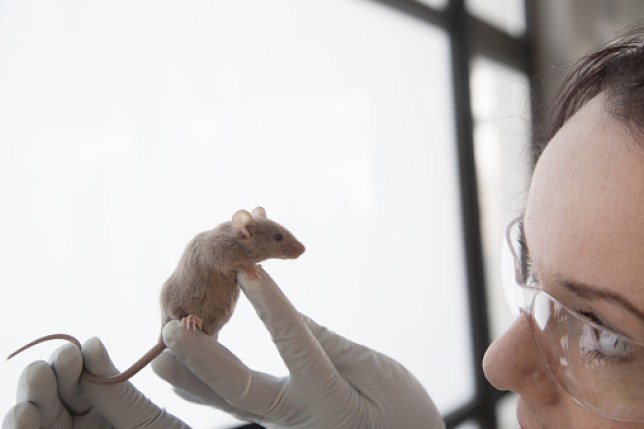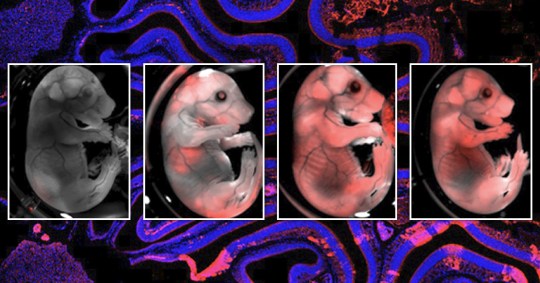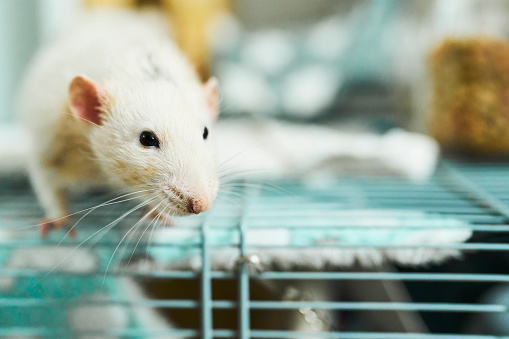Scientists have created a rodent Frankenstein.
In two new studies, researchers from Columbia University and the University of Texas Southwestern have revealed that rat brain cells can fill in for lost neurons in mice.
When they put together rat and mouse brains, they found that the rat brain cells helped the mouse to better understand its environment, and even allowed mice to sniff out sweets.
Dr Kirstin Baldwin, lead author of one study, said the work will help create a better understanding of how mammal brains develop.
‘This research is starting to show us how we can expand the flexibility of a brain so that it can accommodate other kinds of inputs, from human-machine interfaces or transplanted stem cells,’ she said.
Her study looked at how networks form in a hybrid mouse-rat brain. The team used bacterial toxins to either kill or silence brain cells in developing mouse embryos, which were just balls of around 100 to 200 cells, known as blastocysts.
The cells targeted were involved in developing a sense of smell. The team then injected stem cells from rats.
They then implanted the new hybrid blastocysts into mouse mothers and found that the rat cells developed at the same time as the mouse cells, even though naturally, rats develop at a slower pace and have bigger brains.
As the rodent’s sense of smell had been killed or silenced, the team tested to see if it could detect a cookie in its cage.
Some mice found the cookie quicker than others. The researchers found that the mice that had their own sense of smell silenced, rather than killed as an embryo, were less successful.
How to tell the difference between a rat and a mouse
Mice and rats are two entirely different species, although they do look similar.
The two rodents are spotted in similar environments, but have their own life cycles and habitats, usually in the forests, fields and meadows. Rats tend to live up to 12 months, whereas mice can live up to 18 months in the wild.
However, rats are larger and heavier, while mice are smaller and have longer, more hairy tails.
Mice ears seem large compared to their body size, while a rat’s ears will seem balanced with its body size
Dr Baldwin, from the University of Texas (UT) Southwestern, suggests these findings could potentially help create treatments for brain diseases, such as Parkinson’s or Alzheimer’s, with donated or lab-grown cells.
‘Right now, researchers are transplanting stem cells and neurons into people with Parkinson’s and epilepsy. But we do not really understand how well that will work,’ said Dr Baldwin.
‘With hybrid brain models, we can start to get some answers and at a faster pace than a clinical trial.’
Until this study, the technique had not been successful in creating hybrid brains of two different species.
‘What we’re doing is really cutting edge,’ said Dr Baldwin.
Another similar study, which was led by Dr Jun Wu, a molecular biologist at the UT Southwestern Medical Center, focused more on replacing an entire brain region with transplanted cells.
The team used a gene-edited technique known as CRISPR to shut down a gene that shuts off the development of the mouse forebrain in the womb.
They replaced this large brain region with rat cells, and found that while 60% of the cells in the mature mice ended up having rat origin, the animals acted like typical lab mice.
By growing brain tissues from one species inside another, scientists can explore brain development and evolution more widely.
However, these findings would need to go through a primate stage before being raised as a possible way to help treat human conditions.
The studies can be found in the journal Cell, with Dr Baldwin’s study available to read, as well as Dr Wu’s.
MORE : Boston Dynamics just made its robot dog even more terrifying
MORE : China successfully blasts off to the Moon – but what is the plan when it lands?
MORE : Puppy yoga is becoming increasingly controversial – one country has banned it
Get your need-to-know
latest news, feel-good stories, analysis and more
This site is protected by reCAPTCHA and the Google Privacy Policy and Terms of Service apply.














